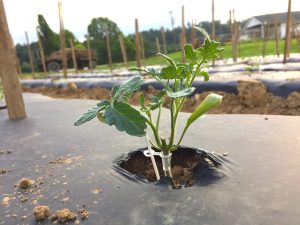Grafted Tomato Projects
In 2020 and 2021 we compared the yield of six field grown tomato rootstock–scion combinations (cultivars Mountain Gem and Jolene; rootstocks Beaufort, Maxifort, and Shincheonggang) and their nongrafted counterparts, pruned or not pruned, at one research station. In both years of the study, yield was higher (P < 0.0001) for plants that were grafted and not pruned compared with nongrafted pruned plants (grower standard). Cultivars Mountain Gem and Jolene had high yield of jumbo and extra-large fruit when grafted onto ‘Maxifort’ or ‘Beaufort’ rootstock. Based on the NC State University 2021 Tomato budget, net return from the treatment where plants were grafted onto ‘Maxifort’ rootstock and not pruned was greater than that from the grower standard practice, although this was the case in one year only. The variable cost of growing grafted plants that were not pruned was always greater than that of the grower standard practice due to the greater cost of transplants and labor associated with harvest. Similar to earlier studies, our results show that higher net returns may be seen with grafted tomato plants in the absence of soilborne disease if plants are not pruned, however, it is advisable to evaluate a small plot of grafted tomato plants on your farm before investing in a large planting due to the high cost of grafted transplants.
See a publication summarizing these results here.
In 2019 we evaluated the yield response of one determinate (‘Mountain Gem’) and four indeterminate (‘Mountain Heritage’, ‘Mountain Girl’, ‘Mountain Rouge’, and ‘NC10291’) tomato cultivars resistant to late-blight, grafted or non-grafted on tomato rootstock ‘Maxifort’. Yield was consistently greater from ‘Mountain Gem’ plants regardless of grafting status, and there were not consistent significant differences in yield between grafted and nongrafted plants between the three locations where these trials were conducted. Our results emphasize the importance of evaluating grafted plants on a limited amount of acreage on your farm before investing in a large planting.
See a publication summarizing these results here.
In 2017 and 2018, we examined different techniques to improve the production of grafted tomatoes. Specifically, we compared 4 rootstocks (Beaufort, Arnold, Shield, and Fortamino [2018 only]), 2 scion varieties (Mountain Fresh Plus, Tasti-Lee), pinching and non-pinching, pruning and non-pruning (Beaufort only; all others were pruned), and spacing (22″ and 24″). All treatments were compared to a grower standard (both varieties, non-grafted, non-pinched, pruned, and spaced at 18″ in-row spacing).
Overall, yields improved with vigorous rootstocks (Beaufort, Arnold, and Fortamino), but were not improved with Shield. Both scion varieties yielded similarly overall. Pruning hurt yields, particularly when plants had been pinched. Grafted plants spaced at 22″ yielded similarly to 24″. Pinched plants increased yields in 2018, but not in 2017. This practice still needs some research for optimizing success.
Click here for a summary presentation.
And a publication summarizing these results.
